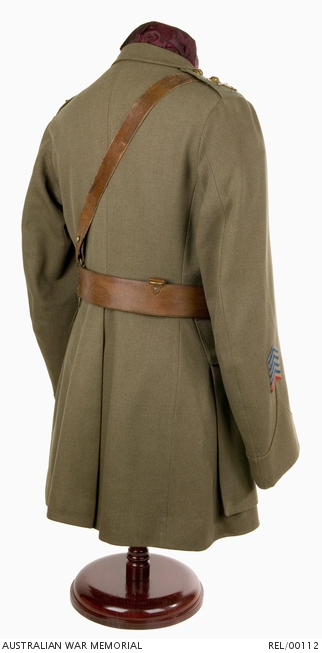| Place | Europe: Western Front |
|---|---|
| Accession Number | REL/00112 |
| Collection type | Heraldry |
| Object type | Uniform |
| Physical description | Brass, Gilded brass, Silk grosgrain, Silver bullion, Superfine wool, Wool, Wool barathea |
| Maker |
Unknown |
| Date made | c 1917 |
| Conflict |
First World War, 1914-1918 |
Khaki service dress tunic : Major General C B B White


Khaki barathea wool tunic with reefer style collar decorated with scarlet superfine gorget patches on the back lapels. Each gorget patch has silver bullion oak leaf embroidery and a single small gilt General Staff button. Khaki shoulder straps have gilt crossed baton and sword insignia and star for the rank of major-general and a small General Staff button. Plain pointed cuffs with four blue above one red overseas service chevrons above right cuff. Two pleated breast pockets with three-pointed flaps and a single small George V button. Two larger expanding lower pockets with plain flaps and a small button. Front is fastened with four large gilt George V buttons made by 'PITT & Co. MADDOX ST LONDON'. Eleven silk ribbon bars above the left breast pocket for: KCMG, CB, DSO, Queen's South Africa Medal, 1914-15 Star, British War Medal, Victory Medal, George V Coronation Medal, Montenegro Medal for Merit (Gold), Portuguese Military Order of Avis and Belgian Croix de Guerre. Tunic has a plain back with centre back skirt vent opening to the waist. Tunic lined with a glossy khaki brown plain weave wool and sleeves with a cream cotton twill.
Worn by Major General Cyril Brudenell Bingham White during the First World War. White was born at St Arnaud, Victoria, in 1876, but spent his early life in Queensland. He joined the Militia in 1896 and in 1899 successfully sat an examination to join the permanent forces, becoming a Lieutenant in the Queensland Regiment of Royal Australian Artillery. He served with the 1st Commonwealth Horse during the Boer War, and after his return to Australia received his first staff appointment, as temporary captain and aide-de-camp to Major General Hutton, commander of the Australian Military Forces. Nominated by Hutton, he attended the British Army Staff College, Camberley, in 1906, and graduated with good results. After several years in England, attached to the British War Office, Brudenell White was recalled to Australia as a major, to become director of military operations at Army Headquarters. At the outbreak of war in 1914 he was selected by Major General Bridges to be chief of staff for the new Australian Imperial Force, and took part in the landing at Gallipoli in April 1915. After the death of Bridges in May, he became chief of staff to the new commander, Lieutenant General Birdwood. Promoted brigadier general in October, White was largely responsible for planning the successful evacuation of Anzac in December. Serving on the Western Front for the remainder of the war, he exerted great influence in his role as staff officer to Birdwood. He was suggested as a suitable leader for the Australian Corps when it was formed in 1918, but remained with Birdwood, becoming senior staff officer to the 5th Army. Disappointed with cuts made to the Australian military after the war, he retired as Chief of the General Staff (CGS) in 1923, to take up civil appointments. In March 1940, after the outbreak of the Second World War, Brudenell White was recalled as CGS, but was killed in an air crash near Canberra on 13 August.
Related information
Conflicts
Events
Places
Subjects
Related Objects
- Car number plate : General Sir Brudenell White, Chief of General Staff, Australian Military Forces
- Pencil: Brigadier General Cyril Brudenell Bingham White, I Anzac Corps, AIF
- Officers' mounted service breeches : General Sir Brudenell White, Chief of General Staff, Australian Military Forces
- 'British Warm' Overcoat : Major General C B B White, Australian Imperial Force
- Collection of badges : General Sir Brudenell White, Chief of General Staff, Australian Military Forces
- Valise for mounted service : Lieutenant C B B White, 1st Australian Commonwealth Horse
- General Sir Cyril Brudenell White
- Major General Sir Cyril Brudenell White
- Pair of officer's tan knee boots : Brigadier General C B B White
- Pair of officer's brown knee boots : Brigadier General C B B White